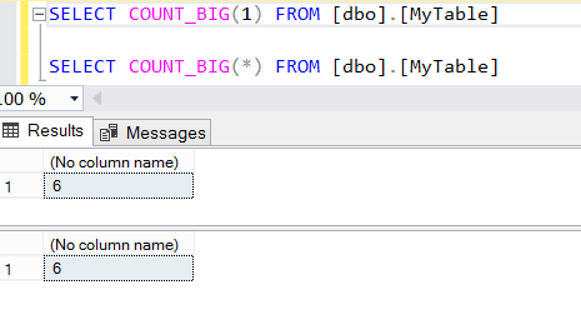The COUNT_BIG function performs the same function as the COUNT function. The only difference is that the COUNT_BIG function returns the BIGINT value while the COUNT function returns int value.
Let’s make examples for a better understanding of COUNT_BIG Function.
Example:
First, we create a table with the help of the following script and add a few records into this table.
1 2 3 4 5 6 7 8 9 10 11 12 | CREATE TABLE [dbo].[MyTable] ([ID] INT IDENTITY, [Name] VARCHAR(20), [Product] VARCHAR(20) ) INSERT [dbo].[MyTable] VALUES ('Hakan GURBASLAR','Product1'), ('Nurullah CAKIR','Product2'), ('Faruk ERDEM','Product3'), ('Nurullah CAKIR','Product4'), ('Nurullah CAKIR','Product5'), ('Hakan GURBASLAR','Product6') |
Let’s calculate the number of records in the table with one of the following queries: (Both queries return the same result. If you type a column name instead of 1 or *, null records are not calculated.)
1 | SELECT COUNT_BIG(1) FROM [dbo].[MyTable] |
or
1 | SELECT COUNT_BIG(*) FROM [dbo].[MyTable] |

Calculate how many products each person has by grouping table by [Name] column:
1 2 3 | Select [Name],COUNT_BIG(Product) AS Product_Count FROM [dbo].[MyTable] GROUP BY [Name] ORDER BY COUNT_BIG(Product) DESC |

![]()
 Database Tutorials MSSQL, Oracle, PostgreSQL, MySQL, MariaDB, DB2, Sybase, Teradata, Big Data, NOSQL, MongoDB, Couchbase, Cassandra, Windows, Linux
Database Tutorials MSSQL, Oracle, PostgreSQL, MySQL, MariaDB, DB2, Sybase, Teradata, Big Data, NOSQL, MongoDB, Couchbase, Cassandra, Windows, Linux 